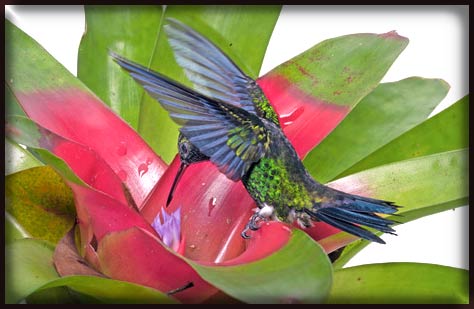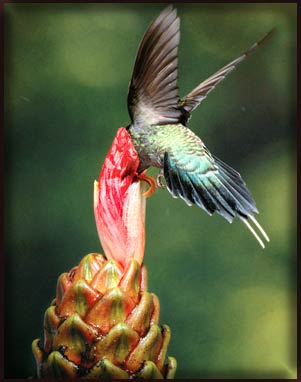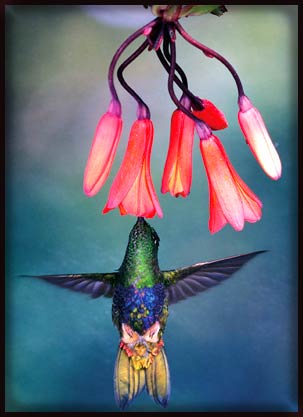Hummingbirds
Suddenly a light of jade flashed, the wings flapped gently and disappeared in the air, an illusion appeared quickly to make it impossible to determine whether it was a bird or an insect. Fortunately, that moment came up again, this time in a better perspective and it could be confirmed that it was exactly a bird - Hummingbird , an intermediate " product " of the process. evolution between insects and birds.
People found this hummingbird in the Americas. According to biologists, hummingbirds have many different varieties and change colors according to geographical regions to adapt to the environment and climate conditions there. Of the 330 species, only 16 have been identified as originating from northern Mexico, the rest cannot be verified because they are known as migratory birds. Their journey may reach 2,500 miles (more than 40,000km): from Alaska to the country of Argentina, from the Arizona desert to the coast of Nova Scotia, from the lowlands in the forests of the Brazilian territory to the Andes .

Colombian hummingbird region.The set of feathers has vivid colors, beneath that beautiful fur are tiny sets of generators that generate energy when they fly.This is the magic of the micro-engineering industry that scientists are studying.
They live wherever they can be. According to scientists, hummingbirds normally raised in cages can live for 17 years. This is amazing compared to a simple organ structure in a small body with an average weight of only 5-6 grams. The heart is tiny but averages 500 beats per minute (while parked). It is estimated that within 17 years the heart beats about 4.5 billion times - almost twice as much as the total beat of a 70-year-old person.


Hummingbirds north of the Andes.The males in this region use purple to dab the hairs on their heads and memories.The feather under the radiation of sunlight forms the synthetic fooling colors of other birds, even the human vision is mistaken.
Hummingbirds in the city.Brilliant neon lights are particularly attractive to " urban " hummingbirds - making them think that the lights are delicious flowers with lots of sweet honey and so on like moths rushing into honey.They also serve to distribute pollen everywhere.Like other insects, hummingbirds cannot distinguish the violet radiation of the light, one can use this to find high-nutrient varieties.
In nature, with thin, sticky wings, it can tap 80 beats per second, emitting a tiny sound. The tail fur is like a paddle " whipping " the wind gently glides in the air. The birds are so flexible when they live, but when they die, their hollow bones are quickly decomposed and never fossilized. That is why no fossil specimens of this bird have been found, although they have been around for a long time.

Hummingbirds south of the Andes.The flashy tail feathers help the males of this region to " charm " the females.If a man uses sparkling jewels to express wealth and power, the aristocratic coat of this bird can be a sign of strong health and abundant energy.
Another characteristic of hummingbirds is an extremely colorful feather. Under the sunlight, the sunbeams pierced through the smooth, iridescent hair, reflecting the glittering colors like the precious stones suspended by someone in space. The more biologists studied, the more surprised they were about the gift of creation for this magical little bird. The words "beautiful", "gorgeous", "strange" . cannot fully describe what people feel about this bird.












Mỹ Dung
- Watch hummingbirds -
- Empty hummingbirds use tricks to flirt with your partner
- Hummingbirds 'snoring' like humans
- How do hummingbirds find mates?
- Unknown things about hummingbirds
- Discover new hummingbird species in Ecuador
- Strange memory of hummingbirds
- Hummingbirds suck bile with their tongue
- Why can hummingbirds float without falling?
- When the prey ambushes the hunter
- Hummingbirds are the fastest animals on the planet
- Improved hummingbird helicopters
 Animal 'suffering' after hibernation
Animal 'suffering' after hibernation Why do goats climb well?
Why do goats climb well? Scientists were surprised to see chimpanzees eating turtles
Scientists were surprised to see chimpanzees eating turtles Giant catfish died deadly due to drought in Thailand
Giant catfish died deadly due to drought in Thailand